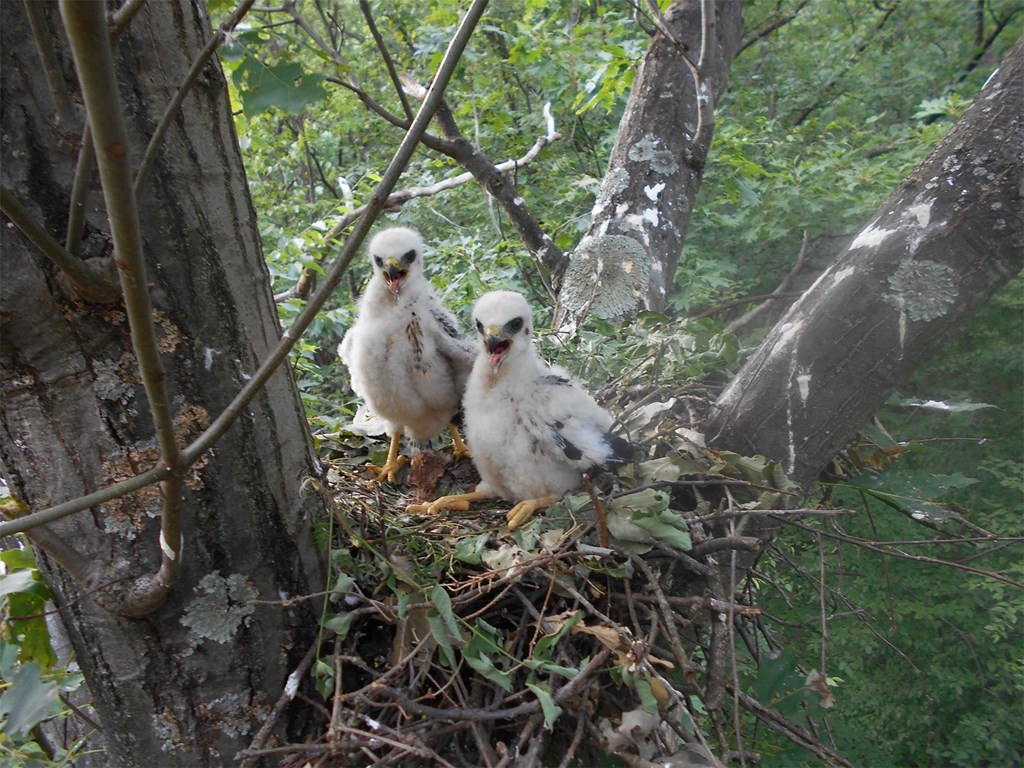Forest Nesting Raptors
As one of the last large blocks of forest in southern and central Pennsylvania, the Kittatinny Ridge provides rich habitat for common, rare, and threatened species of forest raptors and other wildlife. However, little is known about forest raptor use, habitat needs, and distribution across this largest Important Bird Area.
Because raptors serve as indicator species, places where raptors find healthy habitats, are often places where other wildlife thrive as well.
With funding through the Kittatinny Ridge Mini Grant Program, Hawk Mountain collected and analyzed data on Pennsylvania breeding forest raptors to better understand their habitat use within this climate resilient landscape and mega greenway. The resulting factsheets on seven species provide guidelines to protect nesting habitat and information on how private landowners can make a difference.
Habitat & Nesting Information Flyers:
Black Vulture Broad-winged Hawk Cooper's Hawk Red-shouldered Hawk Red-tailed Hawk Sharp-shinned Hawk Turkey Vulture

About the Study
Hawk Mountain scientists and trainees confirmed active nests along the Kittatinny Ridge between 2012-2022 for six out of the seven species and no reported nests for turkey vultures within the period. While more than 1,900 nests were reported across Pennsylvania in eBird, only 103 confirmed nests were reported for the Kittatinny in the decade examined. The Hawk Mountain database provided additional nests to provide a total of 140 confirmed raptor nests for the seven species used in this study. The species with the greatest number of nests was the broad-winged hawk (63 nests) followed by red-tailed hawk (32), black vulture (25), Cooper’s hawk (12), red-shouldered hawk (four), and sharp-shinned hawk (four). Nest locations on the ridge were mapped for analysis with most nests appearing around Hawk Mountain as this area receives higher research attention. Numbers do not indicate abundance of birds but may reflect observer efforts. The higher number of broad-winged hawk nests was due to the ongoing research conducted by Hawk Mountain scientists.
Forest-nesting raptors on the Kittatinny vary in their habitat preferences with broad-winged and sharp-shinned hawks selecting highly forested nest sites with more than 80% forest cover, and the red-tailed hawk, Cooper’s hawk and red-shouldered hawk and the black vulture using areas with more openings, developed, and varied landscape cover. Broadwings and sharpshins also showed lower road density near the nest sites indicating they may seek out less human-altered environments.
Although habitat cover varied around nest sites, the highest amount of developed acreage was found for the generalist raptor, the red-tailed hawk. However, the developed area was less than 15% of the land cover, suggesting that even generalist raptors using the Kittatinny are selecting areas away from development. Despite this finding, redtails are known to nest in suburban and city environments, and we suspect our methods of selecting the Ridge area as our study area may have excluded heavily developed sites. In future analysis we suggest a wider study area could be used and nests on and off the Ridge could be compared.
The two species listed as Species of Conservation Need for Pennsylvania, the broad-winged and sharp-shinned hawk, have both declined as nesting birds south of the Kittatinny Ridge (Wilson et al. 2012) and both were found nesting in more heavily forested areas of the Ridge. While nests may occur in less forested landscapes, these findings suggest forest cover could be important to conserve near nest locations. In addition, evergreen or mixed forest was a notable component of land cover around nest sites. This habitat type occurs less frequently along the Ridge than in northern counties of Pennsylvania and could be encouraged by land managers as it appears to provide a habitat component the raptors value.
In this study, very few confirmed nests could be located in the eBird database. The launch of the Third Pennsylvania Bird Atlas will provide important additional data on nesting birds across the state. It could be particularly important for the Kittatinny Conservation Landscape to locate nest data for Raptors and other Species of Conservation Need to augment conservation planning efforts.
To help support this important research, please contact Director of Conservation Science Dr. Laurie Goodrich (570-943-3411 x106, [email protected]) or donate today using the button below. Be sure to include in the comments of the form that the online gift is for the Forest Nesting Raptors research.